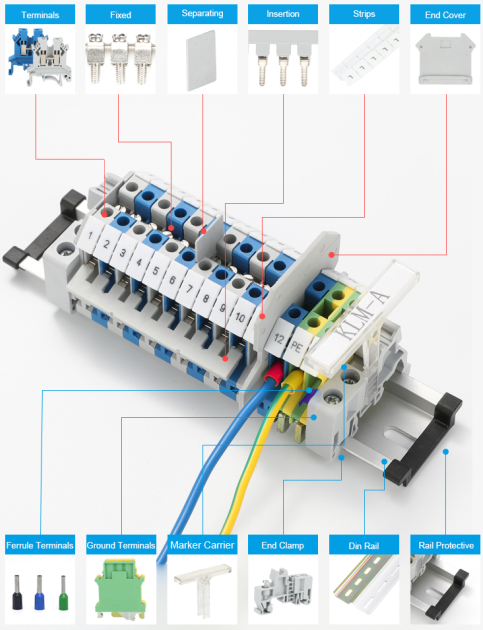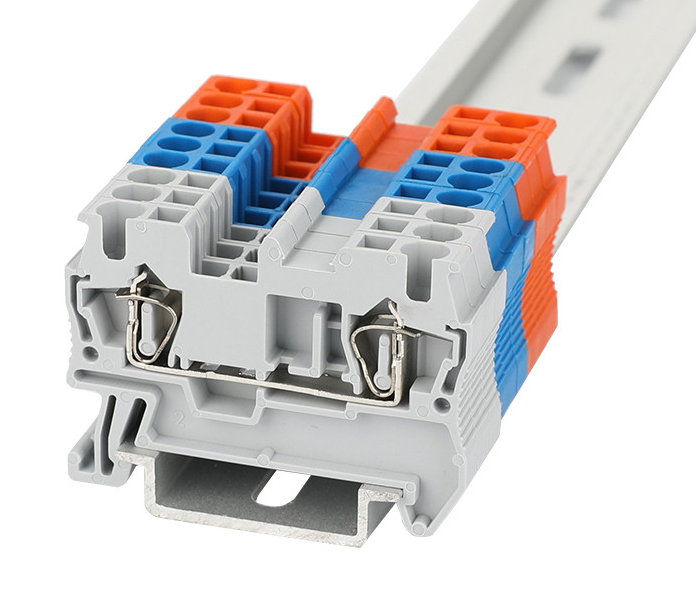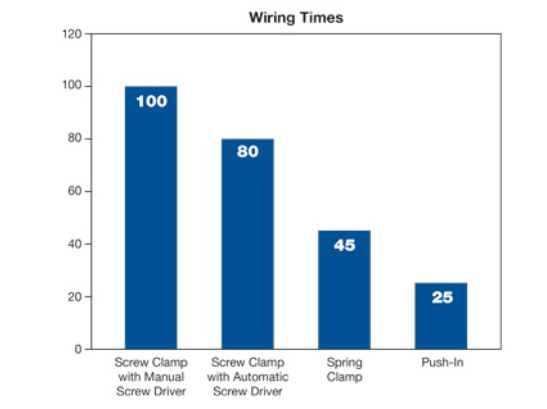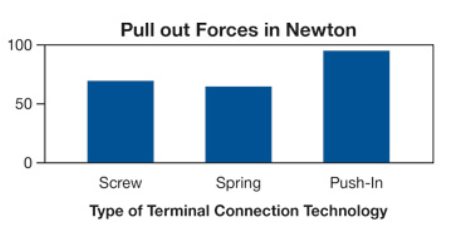Push-In Terminals versus Other Types of Connections
The use of DIN-Rail Terminal blocks is widespread throughout every industry (Fig. 1). For everything from individual machines to complete systems and to multiple system factory interconnections, terminal blocks become an important component.
ELECTRICAL AND ELECTRONICS CONTROL systems use a wide variety of DIN-Rail Terminal blocks with a variety of connection methods dependent on the needs of the application. Electrical panels in automobile plants, chemical plants, utilities, buildings, and all types of automation and manufacturing require hardwired interconnection of some type or another.
Product design engineers have followed the needs of users to create compact products made from a variety of materials for different environments, and which are modular to expand to the needs of the customer. DIN-Rail Terminal blocks have evolved over time. Ultimately, the choice of terminal block must assure to maintain a long life of reliable service, provide as low maintenance as possible, and be able to be installed quickly and efficiently under any conditions.
We’ll discuss the more common connection technology options for your DIN-Rail Terminal block requirements—the screw clamp and the spring DIN-Rail Terminal block—then discuss the features and advantages of push-in type terminals
1. The latest push-in technology for DIN rail terminal blocks allows for 33% more wire density.
Screw terminals are used extensively in the distribution of electricity in homes and apartment buildings, as well as in warehouses, plants and factories inside all types of panels and junction boxes. Screw type terminals have been around for a long time and are the most dependent on human interaction because of screw tightening that is required (often at various torque values). They operate simply by inserting a wire into an open elevator type clamp and tightening down on the screw to the specified torque using a screwdriver. Most screw type terminal blocks also incorporate a locking feature of some kind to guarantee safe connection and prevent the screw from loosening.

2. Screw terminals are used for a broad number of electrical distribution functions where high current might be found.
Screw type terminal blocks are often used when the need is to handle the physical stress of multiple, large wires (sizes up to 250 kcmil) mounted in the same general location as well as handle the large currents going through the wires. Because of the larger wires, these terminal block clamps are made from high-impact materials such as steel to guarantee safe and reliable connections.
Accessories include screw or push-in type jumper systems, end plates, partition plates for separation, and marking options for terminal and wire identification. Another optional terminal block is the Ring Lug/Stud Terminal specifically used for spade or ring (loop) lug terminating

Most engineers working with controllers and inside machine specific interconnection enclosures are familiar with spring clamp terminal blocks . The human factor for these types of connections is less than that of the screw type DIN-Rail Terminal block. A tool, such as a screwdriver, is still needed to open thespring, but a specified torque is not necessary. A safe connection is assured through the use of a preloaded spring.
Spring clamp terminal blocks can handle controller interconnections in a smaller space than screw type terminal blocks.

Operation is easy: By using a narrow screwdriver or similar tool, users push the tool into a slot where it opens a preloaded stainless steep spring. Once a wire is inserted into the terminal, the tool is removed, and the spring force presses the conductor against a copper-tin plated current bar for the connection. Solid or stranded wire can be used to create a secure connection in less time than using a screw terminal. This type of terminal block is also designed into elevator cabinets, machines and vehicles for its natural resistance to vibration and shock.
Spring clamp terminal blocks can be used with all sizes of wire and are actually easier to use on small wires than a screw type block. Conductors can be terminated securely and independently of one another. Not only are these terminal blocks versatile, offering a reliable gas-tight connection, but having no screw to loosen during operation makes them vibration-proof. Like other terminal blocks, spring clamp devices accept wires with or without ferrules to provide a completely maintenance free operation.
Innovative terminal block designs have continued to move forward. Due to the advancements in materials and the needs of specific applications, the possibly tool-less push-in terminal block technology has provided additional benefits to users. This new wiring option allows users to simply push solid wires and stranded wires with ferrules into the terminal block for quick and reliable connectivity. This type of terminal block needs the least human interaction and works well in automated and robotic wiring situations
4.Push-in type DIN-Rail Terminal blocks are becoming very popular with OEMs.
More OEMs are switching to this established technology not only for its installation speed and safety, but for its reliability and extremely large pull-out force (End- users are incorporating push-in terminal block technology to streamline the installation of interconnecting sensor and control devices in I/O and DCS systems for process and automation control.

5. This chart shows the time savings gained from using push-in terminals compared with other types.
Overall, push-in terminals are ideal for many applications with their minimum required insertion force to connect even small wire sizes. These terminal blocks are also suitable to withstand harsh environmental conditions as those found in marine applications and chemical plants, owing to the use of non-ferrous metals used in the connection components.


Scan and follow WeChat